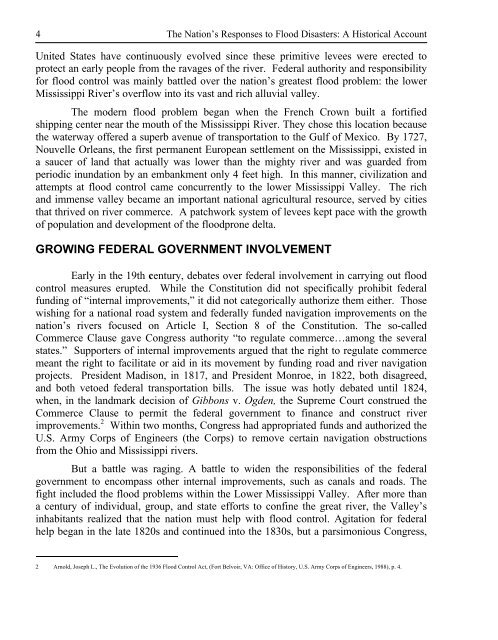The Nation's Responses To Flood Disasters: A Historical Account
The Nation's Responses To Flood Disasters: A Historical Account
The Nation's Responses To Flood Disasters: A Historical Account
Create successful ePaper yourself
Turn your PDF publications into a flip-book with our unique Google optimized e-Paper software.
4<br />
<strong>The</strong> Nation’s <strong>Responses</strong> to <strong>Flood</strong> <strong>Disasters</strong>: A <strong>Historical</strong> <strong>Account</strong><br />
United States have continuously evolved since these primitive levees were erected to<br />
protect an early people from the ravages of the river. Federal authority and responsibility<br />
for flood control was mainly battled over the nation’s greatest flood problem: the lower<br />
Mississippi River’s overflow into its vast and rich alluvial valley.<br />
<strong>The</strong> modern flood problem began when the French Crown built a fortified<br />
shipping center near the mouth of the Mississippi River. <strong>The</strong>y chose this location because<br />
the waterway offered a superb avenue of transportation to the Gulf of Mexico. By 1727,<br />
Nouvelle Orleans, the first permanent European settlement on the Mississippi, existed in<br />
a saucer of land that actually was lower than the mighty river and was guarded from<br />
periodic inundation by an embankment only 4 feet high. In this manner, civilization and<br />
attempts at flood control came concurrently to the lower Mississippi Valley. <strong>The</strong> rich<br />
and immense valley became an important national agricultural resource, served by cities<br />
that thrived on river commerce. A patchwork system of levees kept pace with the growth<br />
of population and development of the floodprone delta.<br />
GROWING FEDERAL GOVERNMENT INVOLVEMENT<br />
Early in the 19th century, debates over federal involvement in carrying out flood<br />
control measures erupted. While the Constitution did not specifically prohibit federal<br />
funding of “internal improvements,” it did not categorically authorize them either. Those<br />
wishing for a national road system and federally funded navigation improvements on the<br />
nation’s rivers focused on Article I, Section 8 of the Constitution. <strong>The</strong> so-called<br />
Commerce Clause gave Congress authority “to regulate commerce…among the several<br />
states.” Supporters of internal improvements argued that the right to regulate commerce<br />
meant the right to facilitate or aid in its movement by funding road and river navigation<br />
projects. President Madison, in 1817, and President Monroe, in 1822, both disagreed,<br />
and both vetoed federal transportation bills. <strong>The</strong> issue was hotly debated until 1824,<br />
when, in the landmark decision of Gibbons v. Ogden, the Supreme Court construed the<br />
Commerce Clause to permit the federal government to finance and construct river<br />
improvements. 2 Within two months, Congress had appropriated funds and authorized the<br />
U.S. Army Corps of Engineers (the Corps) to remove certain navigation obstructions<br />
from the Ohio and Mississippi rivers.<br />
But a battle was raging. A battle to widen the responsibilities of the federal<br />
government to encompass other internal improvements, such as canals and roads. <strong>The</strong><br />
fight included the flood problems within the Lower Mississippi Valley. After more than<br />
a century of individual, group, and state efforts to confine the great river, the Valley’s<br />
inhabitants realized that the nation must help with flood control. Agitation for federal<br />
help began in the late 1820s and continued into the 1830s, but a parsimonious Congress,<br />
2 Arnold, Joseph L., <strong>The</strong> Evolution of the 1936 <strong>Flood</strong> Control Act, (Fort Belvoir, VA: Office of History, U.S. Army Corps of Engineers, 1988), p. 4.
















